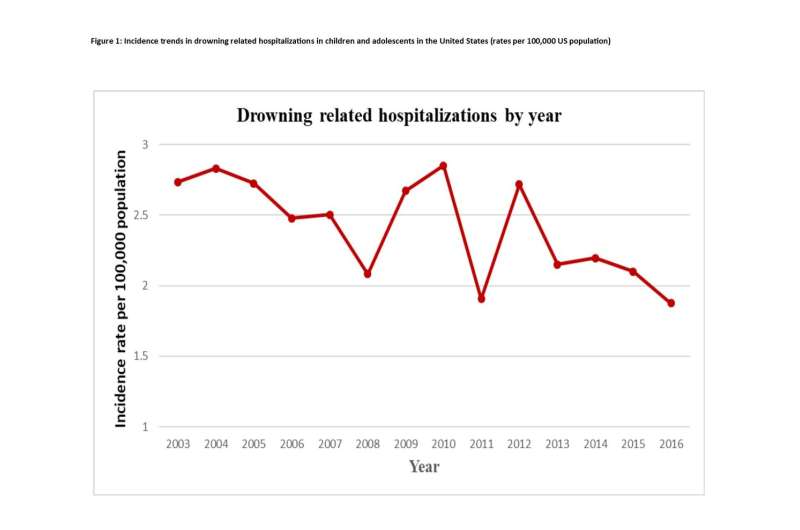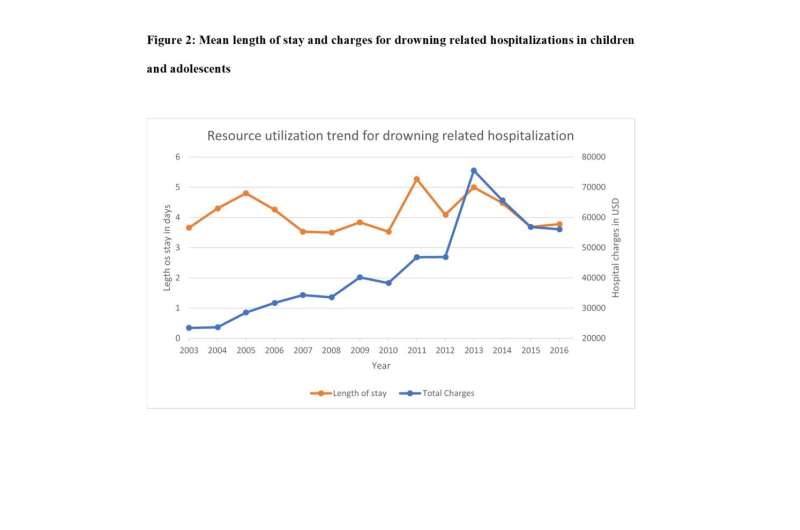Incidence trends in drowning related hospitalizations in children and adolescents in the United States (rates per 100,000 US population) Credit: Krishna Kishore Umapathi. MD
Approximately 1 in 10 children admitted for injuries related to drowning end up dying despite comprehensive medical care after being admitted to a hospital, according to new research being presented at the American Academy of Pediatrics (AAP) 2019 National Conference & Exhibition.
An abstract of the study, "Predictors of In Hospital Mortality in Drowning and Submersion in Children and Adolescents in the United States: A national inpatient database analysis," will be presented on Monday, Oct. 28, in the Ernest N. Morial Convention Center.
"Although there has been a recent decline in drowning-related deaths in children, drowning continues to claim the lives of three children every day in the United States," said abstract author Krishna Kishore Umapathi, MD, a post-residency pediatric cardiology fellow at Rush University Medical Center in Chicago. "It remains the second leading cause of unintentional injury-related death for children ages 1 to 14," he said.
The researchers analyzed 2003-2016 data from a large, population-based inpatient hospitalization database, focusing on all patients up to 20 years of age with a diagnosis of drowning. The data revealed several demographic factors that significantly increased the risk of drowning-related hospitalizations. These included:
- being under 5 years of age, male, and Caucasian
- having public insurance (Medicaid)
Researchers also discovered that drowning hospitalizations were most likely to happen on weekends and in a swimming pool, the researchers discovered. The occurred more frequently in the West and South than in the Northeast or Midwest.
The study, which is the first to describe the predictors of mortality in U.S. pediatric drowning-related hospitalizations, also identified complications from drowning that were significantly associated with a child's death after being hospitalized. These included cerebral edema, acute kidney injury, seizures, cardiac arrhythmia, acute respiratory distress syndrome, and multiple organ dysfunction syndrome.
Mean length of stay and charges for drowning related hospitalizations in children and adolescents. Credit: Krishna Kishore Umapathi. MD
Other factors associated with lower odds of survival after being hospitalized for drowning included a history of autism/intellectual disability, and having needed cardiopulmonary resuscitation, mechanical ventilation, or therapeutic hypothermia.
In addition to the tragic toll drowning has on families and communities, hospitalizations from this preventable injury place a high financial burden on health care system. The average drowning hospitalization charge is $41,000, the study determined.
Abstract authors said they hope their findings help provide better in-hospital care for children admitted for drowning and to increase awareness to prevent child drownings.
"Learning life-saving bystander skills like cardiopulmonary resuscitation and taking precautionary measures like fencing off swimming pools, making life jackets a must, and close parental supervision of kids when they are playing in or near bodies of water can bring these numbers down," Dr. Umapathi said.
Provided by American Academy of Pediatrics

























